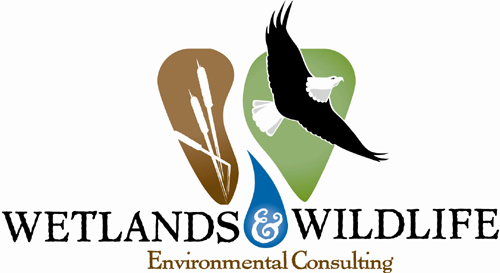|
Services Provided
As evidenced from the list of services provided below, Wetlands & Wildlife
can effectively assist clients with nearly all their environmental project
needs related to regulated wetlands, streams, or wildlife habitat.
Please click on any item for a brief description of each service
provided.
Wetlands & Wildlife provides the following environmental
consulting services for clients:
1) Initial site visits
(reconnaissance)
2) Feasibility analyses
3) Site planning guidance,
including preparation of site plans
4) Wetland delineations
5) Wetland rating forms and
data sheets for report submittal
6) Stream, river, and lake
delineations of Ordinary High Water Mark (OHWM)
7) Wildlife habitat assessments
8) Wildlife surveys
9) Wildlife Habitat Management
Plans and Wildlife Habitat Enhancement Plans
10) Preparation of Floodplain
Habitat Assessment and Mitigation Report
11) High-accuracy Trimble GPS
machine to locate Critical Areas locations
12) Detailed environmental
reports
13) Detailed
mitigation/restoration plans using computer-aided drawings
14) Monitoring of installed
Mitigation Plans and preparation of Monitoring Reports
15) Project
Management--Assistance obtaining development permits
16) Attendance at site or
office meetings with regulatory agency personnel
17) Attendance at public
hearings
18) State Environmental Policy
Act (SEPA)
19) Joint Aquatic Resource
Project Application (JARPA)
20) Assistance when clients
have a code enforcement case on their property

Below is a brief description of each numbered item listed above:
1) Initial site visits (reconnaissance) conducted to
determine if any regulated Critical Areas exist on a property that may
affect current or future proposed development. Initial visits can be
completed at the request of a property owner, the property owner’s primary
contact person, or a prospective buyer if a property is for sale (as long
as the property owner provides written permission to access the property);
(NOTE: Wetlands & Wildlife recommends that prospective buyers complete
this step before the real estate transaction is completed so that no
surprises related to Critical Areas come up after the purchase is already
completed) Back to top
2) Feasibility analyses conducted to determine if a
client’s desired development plan will impact a regulated critical area or
associated buffer area. This service can save clients time and money
because it is important to be aware of Critical Areas regulations before
paying money to have an architect or engineer design a project that can’t
be approved due to Critical Areas regulations
Back to top
3) Site planning guidance, including preparation of site
plans as required by the federal, state, and local jurisdictions. An
accurate site plan shows all proposed development and all existing
conditions including existing structures, existing access, easements, etc.
Wetlands & Wildlife prepares quality professional site plans and maps by
using a computer-aided drawing program
Back to top
4) Wetland delineations conducted in accordance with the
Army Corps of Engineers Wetland Delineation Manual and the Washington
State Wetland Delineation Manual. This step is required if it is
determined during prior steps that any regulated wetland areas or
associated protective buffer areas are located on the project site that
may be affected by a proposed development activity
Back to top
5) Wetland rating forms and data sheets for report
submittal are completed to determine a wetland’s regulatory
classification. The number of points scored on the rating form dictates
the category of wetland and the associated regulatory buffer setback
required between a proposed development activity and the wetland. The
rating form used during the site evaluation was produced by the Washington
Department of Ecology, while the data sheet used by Wetlands & Wildlife,
Inc. was produced by the Army Corps of Engineers
Back to top
6) Stream, river, and lake delineations of Ordinary High
Water Mark (OHWM) conducted using current OHWM guidelines provided by the
Washington Department of Ecology. The OHWM is not always the top of bank
and is not always as obvious as it may appear. Wetlands & Wildlife is
trained and experienced to determine OHWM using current field assessment
methods Back to top
7) Wildlife habitat assessments conducted to determine if
habitat for threatened, endangered, and special status wildlife species
occurs on a proposed development site. Detailed wildlife habitat
assessments are required by multiple jurisdictions based on site
characteristics Back to top
8) Wildlife surveys completed to determine
presence/absence/abundance of any threatened, endangered, or special
status wildlife species if the wildlife habitat assessment determines that
a species protected by a federal, state, or local regulation may be
utilizing a given property
Back to top
9) Wildlife Habitat Management Plans and Wildlife Habitat
Enhancement Plans completed as required by many jurisdictions in our
region. Habitat Management Plans are required when prior biological
reviews determine that a species listed as endangered or threatened under
the Endangered Species Act has a primary association with the proposed
development site. Habitat Enhancement Plans are often prepared as a
portion of a mitigation plan intended to offset an impact associated with
a proposed development activity
Back to top
10) Preparation of Floodplain Habitat Assessment and
Mitigation Report. A document produced by the Federal Emergency Management
Agency (FEMA) and just released in early 2010 requires many development
projects proposed within a mapped floodplain to have a detailed study
conducted prior to permit approval to evaluate effects of the proposed
development on species listed under the Endangered Species Act (ESA).
Wetlands & Wildlife has the necessary experience to complete this detailed
habitat assessment and provide mitigation recommendations for clients as
required by regulatory agencies to assist in permit approval
Back to top
11) High-accuracy Trimble GPS machine used to collect
data and locate delineation flags on a site. Depending on each client’s
project goals and the site-specific characteristics, clients may be able
to take advantage of this service by locating Critical Areas flag
locations with a high-accuracy global-positioning system (GPS) machine and
thereby avoiding the need to hire a professional land surveyor to locate
the wetland flags. Using a highly accurate GPS machine to locate
delineation flags can save the client money because they don’t have to
hire a professional surveyor to locate the delineation flags, yet the GPS
machine can produce data collection results accurate within 12 inches or
less. The map created from this high-accuracy GPS machine also aids in
preparation of an accurate site plan and the detailed
mitigation/restoration planting plan when imported into our computer-aided
drawing program. NOTE: Certain projects (plats, short plats, etc.) will
require a professional land survey before agency approval, but this
high-accuracy GPS machine can be used on many other project types to
assist clients Back to top
12) Detailed environmental reports prepared for clients
which discuss any regulated critical areas on the site and current or
future development proposals as they relate to the applicable
environmental regulations to assist clients with project approval from all
necessary environmental review agencies (federal, state, and local). The
list of environmental reports includes of Critical Areas Studies,
Biological Assessments, Biological Evaluations, and Proposed Mitigation or
Restoration Plans Back to
top
13) Detailed mitigation/restoration plans prepared in
accordance with the regulatory agencies’ guidelines to assist clients with
project approval from all necessary environmental review agencies
(federal, state, and local). These detailed reports include a text
component and a map/visual component of proposed mitigation/restoration
through use of a computer-aided drawing program which provides quality
professional maps that are scaled and accurate. Wetlands & Wildlife’s
ability to draw detailed schematic planting plans assists clients because
they don’t have to retain a separate landscape architect to complete the
planting plan for them Back
to top
14) Monitoring of installed Mitigation Plan and
preparation of Monitoring Reports. Once a mitigation/restoration plan has
been approved by a regulatory agency and installed per the approved plans,
Wetlands & Wildlife monitors the installed mitigation plans for clients to
ensure performance standards outlined in the mitigation plan are met. An
annual monitoring report is completed for submittal to the regulatory
agency, complete with a description of the mitigation site’s status and
photographs. At the end of the mitigation monitoring and maintenance
period outlined in the mitigation plan, a final report is submitted to
show that all mitigation performance standards have been met
Back to top
15) Project management--Assistance obtaining development
permits when a jurisdiction’s environmental code requires a permit to be
obtained. Wetlands & Wildlife can assist clients with the often cumbersome
and daunting federal, state, county, and city environmental permitting
processes Back to top
16) Attendance at site or office meetings with regulatory
agency personnel. At the client’s request, Wetlands & Wildlife attends
meetings with staff members of environmental review agencies acting on
behalf of clients to determine the most efficient and cost-effective
approach at achieving approval of the proposed development project.
Meeting attendance can be critical to making sure clients understand what
is required of them to obtain permit approval
Back to top
17) Attendance at public hearings and legal
meetings completed on behalf of clients as the technical Critical Areas expert for
wetland, stream, and protected wildlife habitat regulations. I have
attended several public hearings as the lead technical expert related to
code enforcement cases involving Critical Areas issues
Back to top
18) State Environmental Policy Act (SEPA) checklists
submitted to the appropriate review agency (only if your project requires
this to be completed) Back
to top
19) Joint Aquatic Resource Project Application (JARPA)
submitted to the appropriate review agency (only if your project requires
this to be completed)
Back to top
20) Assistance when clients have a code enforcement case
on their property. In the unfortunate case that a code enforcement case
has been opened on a client’s property related to Critical Areas, Wetlands
& Wildlife can assist with determining if any violation of the federal,
state, or local environmental regulations did in fact occur. If it is
determined that a violation did occur, Wetlands & Wildlife assists the
client with rectifying the violation to get the property into compliance
so that the code enforcement case can be closed.
Back to top
|


